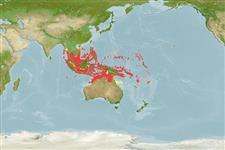Actinopterygii (ray-finned fishes) >
Perciformes (Perch-likes) >
Scombridae (Mackerels, tunas, bonitos) > Scombrinae
Etymology: Rastrelliger: Latin, rastra = rake + Latin, gero = to carry.
Environment / Climate / Range
Ecology
Marine; brackish; pelagic-neritic; oceanodromous (Ref. 51243); depth range 15 - 200 m (Ref. 28016). Tropical; 20°C - 30°C (Ref. 54858), preferred 28°C (Ref. 107945); 18°N - 18°S, 93°E - 180°E (Ref. 54858)
Pacific Ocean: Andaman Sea to Thailand, Indonesia, Papua New Guinea, Philippines, Solomon Islands and Fiji.
Length at first maturity / Size / Weight / Age
Maturity: Lm 17.0 range ? - ? cm
Max length : 34.5 cm FL male/unsexed; (Ref. 168); common length : 20.0 cm FL male/unsexed; (Ref. 168)
Dorsal
spines
(total): 8 - 11;
Dorsal
soft rays
(total): 12;
Anal
spines: 0;
Anal
soft rays: 12. Snout pointed. Maxilla covered by lachrymal bone but extending nearly to end of lacrimae. Interpelvic process small and single. Swim bladder present. Vertebrae 13 precaudal plus 18 caudal, total 31. Bristles on longest gill raker about 150 on one side in specimens of 12.7 cm, 210 in specimens of 16 cm, and 240 in specimens of 19 cm fork length. Anal spine rudimentary.
Found in estuarine habitats with slightly reduced salinities and in areas where surface temperature range between 20° and 30°C, forming schools of equally sized individuals. Batch spawning is believed to extend from March through September (Ref. 9684). Feeds chiefly on microzooplankton with a high phytoplankton component. Marketed fresh, frozen, canned, dried salted and smoked.
Life cycle and mating behavior
Maturity | Reproduction | Spawning | Eggs | Fecundity | Larvae
Collette, B.B. and C.E. Nauen, 1983. FAO Species Catalogue. Vol. 2. Scombrids of the world. An annotated and illustrated catalogue of tunas, mackerels, bonitos and related species known to date. Rome: FAO. FAO Fish. Synop. 125(2):137 p. (Ref. 168)
IUCN Red List Status (Ref. 115185)
CITES (Ref. 94142)
Not Evaluated
Threat to humans
Harmless
Human uses
Fisheries: highly commercial; gamefish: yes
Tools
Special reports
Download XML
Internet sources
